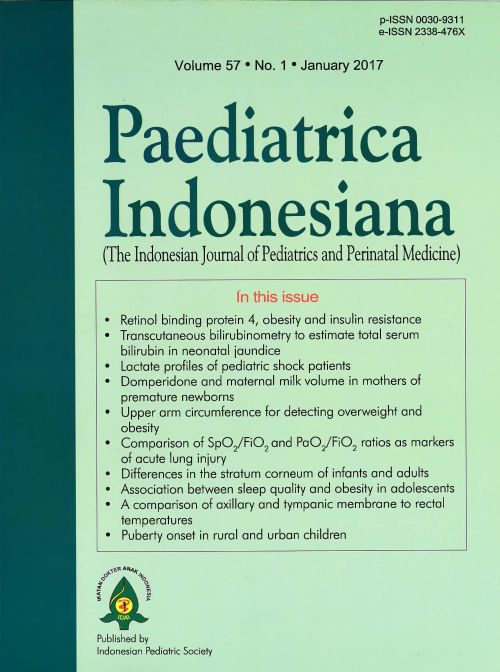Lactate profiles of pediatric shock patients in Cipto Mangunkusumo General Hospital 2015: a pilot study
Abstract
Background The 2015 Surviving Sepsis Campaign (SSC) guidelines for management of shock recommend blood lactate to assess the success of resuscitation in shock. However, a study in adults found that 1/3 of septic shock patients had normal lactate levels (alactatemia) and lower mortality rates.
Objective To evaluate lactate profiles, possible factors affecting lactate levels, and mortality outcomes in pediatric shock patients in the emergency room (ER) and pediatric intensive care unit (PICU).
Methods This was a retrospective study on pediatric shock patients aged 1 month to 18 years in the ER or PICU  from June 2014 to December 2015. Data were taken from subjects’ medical records including lactate levels, examination data required to calculate a PELOD score, and mortality outcomes.
Results Of 223 shock patients evaluated, only 92 cases (41.2%) underwent lactate examinations. Of these, 59 (64.1%) had alactatemia and 33 (35.9%) had hyperlactatemia. A total of 23.7% of the alactatemia group and 36.4% of the hyperlactatemia group died, thus, the initial lactate level was not significantly associated with patient outcomes (P=0.197). The mortality rates of patients with <10% and ³10% lactate clearance were 31.3% and 17.6%, respectively (P=0.362).
Conclusion In alactatemia patients, lactate level can not be used as a goal for resuscitation. Further study is needed to find a biomarker for assessing the success of pediatric shock resuscitation. Moreover, the clinical relevance of alactatemia is uncertain in pediatric shock patients.
References
Carcillo JA, Kuch BA, Han YY, Day S, Greenwald BM, McCloskey KA, et al. Mortality and functional morbidity after use of PALS/APLS by community physicians. Pediatrics. 2009;124:500-8.
Sinniah D. Shock in children. IeJSME. 2012;1:129-36.
Santhanam I, Sangareddi S, Venkataraman S, Kissoon N, Thiruvengadamudayan V, Kasthuri RK. A prospective randomized controlled study of two fluid regimens in the initial management of septic shock in the emergency department. Pediatr Emerg Care. 2008;24:647-55.
Dellinger RP, Levy MM, Rhodes A, Annane D, Gerlach H, Opal SM, et al. Surviving Sepsis Campaign: international guidelines for management of severe sepsis and septic shock: 2012. Crit Care Med. 2013;41:580-637.
Surviving Sepsis Campaign. Update bundles in response to new evidence. [cited 2015 September15]. Available from: htttp://www.survivingsepsis.org/sitecolletionDocuments/SSC_Bundle.pdf
Napoli AM, Seigel TA. The role of lactate clearance in the resuscitation bundle. Crit Care. 2011;15:199.
Hernandez G, Castro R, Romero C, de la Hoz C, Angulo D, Aranguiz I, et al. Persistent sepsis-induced hypotension without hyperlactatemia: is it really septic shock? J Crit Care. 2011;26:9-14.
Zhang Z, Xu X, Chen K. Lactate clearance as useful biomarker for the prediction of all-cause mortality in critically ill patients: a systematic review study protocol. BMJ Open. 2014;4:1-4.
Metta D, Soebardja D, Hudaya D. The use of pediatric logitic organ dysfuntion (PELOD) scoring system to determine the prognosis of patient in pediatric intesive care unit. Pediatrica Indonesiana. 2006; 46:1-6.
Fisher JD, Nelson DG, Beyersdorf H, Satkowiak LJ. Clinical spectrum of shock in the pediatric emergency department. Pediatr Emer Care. 2010;26:622-5.
Agrawal S, Sachdev A, Gupta D, Chugh K. Role of lactate in critically ill children. Indian J Crit Care Med. 2004;8:173-81.
Na S, Joshi M, Li CH, Mahadevan M, Varma A, Lee CC, et al. Implementation of a 6-hour severe sepsis bundle in multiple Asian countries is associated with decreased mortality. Chest. 2009;136:20S.
Cannon CM, Holthaus CV, Tubrow MT, Posa P, Gunaga S, Kella V, et al. The GENESIS Project (GENeralized Early Sepsis Intervention Strategies): A multicenter quality improvement collaborative. Journal of Intensive Care Medicine. 2012:28: 355-68. doi: 10.1177/0885066612453025.
Munde A, Kumar N, Beri RS, Puliyel JM. Lactate clearance as a marker of mortality in pediatric intensive care unit. Indian Pediatr. 2014;51:565-7.
Patriawati KA, Nurnaningsih N, SuryantoroP. Serial blood lactate levels as a prognostic factor for sepsis mortality. Paediatr Indones. 2014;54:6.
Levinson AT, Casserly BP, Levy MM. Reducing mortality in severe sepsis and septic shock. Semin Respir Crit Care Med. 2011;32:195-205.
Saraswati DD, Pudjiadi AH, Djer MM, Supriyatno B, Syarif DR, Kurniati N . Faktor risiko yang berperan pada mortalitas sepsis. Sari Pediatri. 2014;15:281-8.
Ismy J, Munar L, Mutiara E, Yani GN, Trisnawati Y. PELOD score, serum procalcitonin, and lactate level in pediatric sepsis. Pediatr Indones. 2015;55:4.
Phypers B, Pierce JMT. Lactate physiology in health and disease. Anaesth Crit Care Pain. 2006;6:128-32.
Authors who publish with this journal agree to the following terms:
Authors retain copyright and grant the journal right of first publication with the work simultaneously licensed under a Creative Commons Attribution License that allows others to share the work with an acknowledgement of the work's authorship and initial publication in this journal.
Authors are able to enter into separate, additional contractual arrangements for the non-exclusive distribution of the journal's published version of the work (e.g., post it to an institutional repository or publish it in a book), with an acknowledgement of its initial publication in this journal.
Accepted 2017-01-18
Published 2017-02-28













